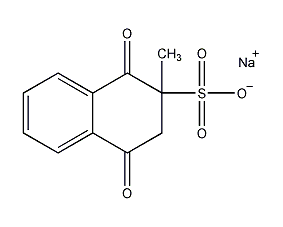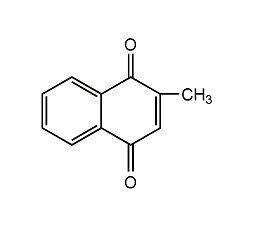2-Methyl-1,4-naphthoquinone sodium bisulfate 2-Methyl-1,4-naphthoquinone sodium bisulfate


Structural formula
| Business number | 03MJ |
|---|---|
| Molecular formula | C11H9NaO5S |
| Molecular weight | 276.24 |
| label |
1,2,3,4-Tetrahydro-2-methyl-1,4-dioxo-2-naphthalenesulfonic acid sodium salt, Menaquinone sodium bisulfite, Menaquinone sodium bisulfite, Menadione sodium bisulfite, aromatic compounds |
Numbering system
CAS number:130-37-0
MDL number:MFCD00051456
EINECS number:204-987-0
RTECS number:None
BRN number:None
PubChem number:24897038
Physical property data
1. Melting point (ºC): Uncertain
2. Boiling point (ºC, 0.67kpa or 5 mmHg): Uncertain
3. Refractive index: Uncertain
p>
4. Flash point (ºC): Uncertain
5. Specific rotation (ºC): Uncertain
6. Autoignition point or ignition temperature (ºC ) Uncertain
7. Vapor pressure (kPa, 25ºC): Uncertain
8. Saturated vapor pressure (kPa, 60ºC): Uncertain
9 . Heat of combustion (KJ/mol): Uncertain
10. Critical temperature (ºC): Uncertain
11. Critical pressure (KPa): Uncertain
12. The logarithmic value of the oil-water (octanol/water) partition coefficient: Uncertain
13. Explosion upper limit (%, V/V): Uncertain
14. Explosion Lower limit (%, V/V): Uncertain
15. Solubility: Easily soluble in water, slightly soluble in ethanol, insoluble in ether or benzene.
Toxicological data
1. Other multiple dose toxicity: rat intravenous TDLO: 500mg/kg/9D-I
2. Mutagenicity: inhibition of human leukocyte DNA: 25umol/L
Inhibition of human cell DNA: 50umol/L
Human leukocyte mutation test system: 50umol/L
Human cell mutation test system: 25umol/L
Ecological data
None yet
Molecular structure data
None yet
Calculate chemical numbersAccording to
1. Reference value for hydrophobic parameter calculation (XlogP): None
2. Number of hydrogen bond donors: 0
3. Number of hydrogen bond acceptors: 5
4. Number of rotatable chemical bonds: 1
5. Number of tautomers: 2
6. Topological molecule polar surface area 99.7
7. Number of heavy atoms: 18
8. Surface charge: 0
9. Complexity: 466
10. Number of isotope atoms: 0
11. Determine the number of atomic stereocenters: 0
12. Uncertain number of atomic stereocenters: 1
13. Determine the number of chemical bond stereocenters: 0
14. Number of uncertain chemical bond stereocenters: 0
15. Number of covalent bond units: 2
Properties and stability
None yet
Storage method
None yet
Synthesis method
Using o-menaquinone as raw material, it is produced through oxidation and addition.
Purpose
It can promote the synthesis of prothrombin in the liver of livestock and poultry, and promote the synthesis of plasma coagulation factors in the liver.
